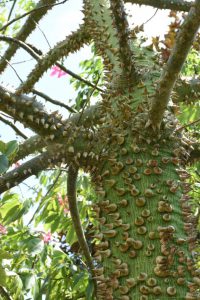A tree of a different color
In Central Florida, we are in Zone 9b, which leaves us out of the range for a lot of flowering trees like those from the rosaceae family (i.e., flowering pears and cherries) and dogwoods used in most of the Eastern U.S. However, what the Central Florida landscape loses in classic temperate appeal is exceedingly compensated with a more diverse palette of flowering trees. The silk-floss tree (Ceiba speciosa) represents a certain hue of these offerings. Another Central Florida advantage, flowering can be extended throughout different seasons of the year. The light pink to dark magenta blooms are present throughout the fall into winter.
A thorny past
This tree bears defenses from a different time. Originally, it was speculated that these thorns were to discourage primates and other climbing animals, but they actually represent little obstacle to these small animals. It has since been surmised that the thorns were a defense from extinct megafauna – in particular against megatherium (i.e., giant ground sloths). This is similar to other trees with vicious armaments that protect thin bark like the honey locust (Gleditsia triacanthos). The silk-floss tree is actually very drought tolerant, in part from this thin bark. When trees photosynthesize from leaves, they often lose a lot of water. However, when this process of carbon fixation occurs in stems or branches, the water is usually better retained. In some sense, during dry periods where these trees lose their leaves, they act more like succulents or cactuses.
The home landscape
Silk-floss trees prefer well-drained to occasionally wet soil. The tree itself is “medium-sized,” reaching both a height and width of approximately 50 ft. These trees are not widely available in nurseries, but a little searching will yield some results (e.g., https://www.plantsearch.com/plant-search). A less intimidating and thorn-free hybrid cultivar is also available and known as ‘Monsa’ (https://hort.ifas.ufl.edu/database/documents/pdf/tree_fact_sheets/chospec.pdf). For a more in-depth view of this tree, check out its profile on the UF/IFAS EDIS webpage (https://edis.ifas.ufl.edu/st164).
 4
4


